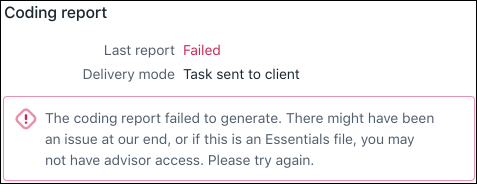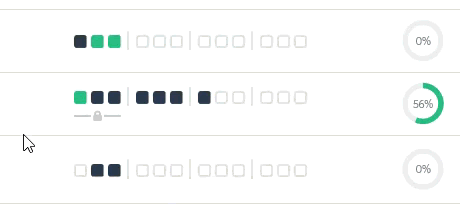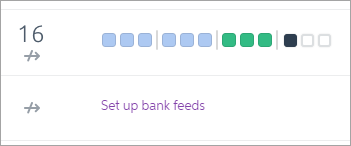The Online files view is your main page under Transaction processing, which lists all MYOB Essentials files, MYOB Business files, and online MYOB AccountRight company files you’ve created or that a staff member's given you access to. This makes it easy for you to keep on top of your client work. Quickly see which business files are up to date, and which you need to work on next. 
The columns that you see depend on whether you're working with BAS (Australia only) and whether you've hidden any columns. You can see: - how many transactions remain to be allocated
- which months have been allocated and reconciled for the current and previous financial years
- the percentage of transactions that have been automatically allocated based on allocation rules in MYOB Essentials/MYOB Business over the last 2 months
- whether they're taking advantage of bank feeds to minimise data-entry work
- see when their next activity statement is due, and its status (Australia only).
What you can see and do for each client also depends on whether you use compatible practice software like MYOB AE/AO. Common tasksHere are some tasks you can do from the Online files view: Get the most out of the Transaction processing pageHere are some tips that'll have you working with online files like a pro! Sort the page| UI Expand |
|---|
| You can sort your business list by any column. For example, click the Unallocated column header, and the businesses with the most unallocated transactions will appear first, so you can get to work right away. Or click the Automated header to see which businesses are not taking advantage of allocation rules to improve efficiency. To reverse the sort order, click the header again. |
| UI Expand |
|---|
| Right-click on the header of the list to choose the columns that you'd like to see. 
| UI Text Box |
|---|
| BAS (Australia only) and non-BAS users will see different options to choose from. You can't select columns when you're in detailed view or on a mobile device. |
|
Get a quick overview| UI Expand |
|---|
| title | View unallocated transactions |
|---|
| | UI Text Box |
|---|
| Transaction information isn't available: - if you use AE/AO Practice Ledger
- for your clients who have MYOB Business Payroll Only and or MYOB Essentials Payroll.
|
See how many transactions remain to be allocated for each client, across all their bank accounts for the selected 12 months. 
Click the Unallocated indicator to review the bank feed transactions that still need to be allocated: For MYOB Essentials businesses: Clicking Unallocated will take you straight to the Bank transactions page, and filter to show what’s unallocated for the selected 12 months. | UI Text Box |
|---|
| Don't have enough information to code the unallocated transactions? Send your clients a coding report so they can provide the transaction details for you. |
For businesses using MYOB Business/new MYOB Essentials: Clicking Unallocated will take you to the Bank transactions page, where you can select the bank account you want to review transaction for. - For MYOB AccountRight businesses: When you click Unallocated, AccountRight will start (requires AccountRight Launcher), and you'll need to sign in to the company file with your user ID and password. To allocate the bank feed transactions, go to the Banking command centre and click Bank Feeds.
|
| UI Expand |
|---|
| title | Colour coding helps you track what needs doing |
|---|
| For each business, you can see at a glance which months have unallocated transactions or which bank accounts need reconciling. 
Here's what the colours indicate: | Colour | Meaning |
|---|
Black ( ) ) | This indicates there are transactions that haven't yet been coded in this calendar month for all or some of your client's bank or credit card accounts. We recommend that you code these transactions to get them ready for reconciliation.
| Green ( ) ) | This indicates that you have coded all of the bank and credit card transactions but not all of the bank or credit card account transactions have been reconciled yet for that calendar month. We recommend that your client completes as much of their bank reconciliation as possible prior to migration in line with your established processes and agreements with your client. | Blue ( ) ) | All transactions have been reconciled for your client's bank and credit card accounts for that calendar month. | White ( ) ) | No transactions are available for the month. |
| UI Text Box |
|---|
| The reconciliation status takes into account all bank and credit card accounts in the file, whether they have an active bank feed or not. |
Click in the status area to start allocating transactions: - For MYOB Essentials businesses: When you click the transaction indicators, the Bank transactions page in MYOB Essentials will appear, and it will list all transactions for the selected 12 months, regardless of the last filter applied in the Bank transactions page. Learn how to allocate transactions in MYOB Essentials.
- For businesses using the new MYOB Essentials/MYOB Business: When you click the transaction indicators, the Bank transactions page appears, where you can select the bank account you want to review transaction for. Learn how to allocate transactions in the new MYOB Essentials/MYOB Business.
- For MYOB AccountRight businesses: When you click the transaction indicators, AccountRight will start (requires AccountRight Launcher). You'll need to sign in to the company file with your user ID and password. To code the bank feed transactions, go to the Banking command centre and click Bank Feeds. Learn how to work with bank feeds in MYOB AccountRight.
|
| UI Expand |
|---|
| title | Improve your practice's efficiency |
|---|
| Allocation rules take the effort out of allocating each and every bank transaction. Now you can see what percentage of your clients’ transactions over the past two months were automatically allocated for you. 
Click the percentage to create allocation rules: - For MYOB Essentials/MYOB Business files: When you click the percentage, you can create allocation rules in MYOB Essentials right away. Aim high — the more you automate, the less time you'll spend on low-value data-entry work and following up unallocated transactions.
- For MYOB AccountRight files: When you click the percentage, AccountRight will start (requires AccountRight Launcher). You'll need to sign in to the company file with your user ID and password. To create rules in AccountRight, go to the Banking command centre, click Bank Feeds, and then click Manage Rules.
|
| UI Expand |
|---|
| title | Identify AccountRight files that are checked out |
|---|
| When a client needs to work without an internet connection, they'll check out their AccountRight file to a PC or device. That means the online copy of their file will become read-only. You'll see a Checked out label next to the client's business name, to let you know the client is working offline. 
When an AccountRight file is checked out, you can still launch it but you can't make changes to it. The transaction status indicators won't reflect any changes the client has made while working offline, or any bank feed updates that have occurred until the file is checked in again. |
| UI Expand |
|---|
| title | Track and manage coding reports |
|---|
| In the Last report column, you can see the status of all the coding reports that you've generated for your clients. This is useful for easily seeing if there are any reports you might need to follow up. You can even see what method was used to send the report—whether by emailing the report, downloading and manually sending report, or sending the report via Tasks. 
| UI Text Box |
|---|
| By default, the column is sorted to show failed reports to help you quickly identify reports that may need your attention. But you can click the Last reports column header to sort the list by date. |
| Icon/status | Description |
|---|
| The report was emailed to the client from within MYOB Practice. | | A staff member in your practice downloaded the file to manually send to the client. | | The report was sent via Tasks. | | Date (e.g. 21 Jul 2020) | The date that the coding report was sent to the client. | | In progress | The report has been sent to the client on the date shown. You can click the Online files entry for this file to see more details. From here, you can click View task to go straight to the Tasks page where you can see all the details and view the coding report. 
| UI Text Box |
|---|
| If you want to make changes to the coding report, you can download it from the Tasks page, make and save your changes, then re-upload it to the same task. |
| | Failed | There was an error while the report was being generated. Click the Online files entry for this file to see more details. 
The report generation may have failed because of an issue on our end or because of an MYOB Advisor access issue. You can try to generate the report again and, if it still fails, contact support. | | No Data | There's no data to report on for the period that the report was generated. Click the Online files entry for this file to see more details. 
|
| UI Text Box |
|---|
| You can hover over the status icons to see a reminder about what the icon means. 
|
|
| UI Expand |
|---|
| title | Check for locked periods |
|---|
| For MYOB Essentials/MYOB Business and MYOB AccountRight files (version 2018.1 and later), you can now see which months in your client files are locked. 
This makes it easier to check that the periods you've reviewed and completed in your client files have been locked for editing. Locking a period you've reported to the ATO or IR is a great safeguard to ensuring the records are not changed accidentally. Learn about locked periods: MYOB AccountRight | MYOB Essentials (old) | MYOB Essentials (new)/MYOB Business | UI Text Box |
|---|
| If the locked period ends part way through a month, the locked period indicator will span only the full months that are locked. When you hover over the padlock icon you'll see the exact date the locked period ends. |
|
| UI Expand |
|---|
| title | Set up bank feeds quickly |
|---|
| If a client doesn't have a bank feed, you can apply for one by clicking the Set up bank feeds link. If transactions have been imported in a file (eg using a QIF file), you'll see the  icon below the number of unallocated transactions — click it to set up a bank feed. icon below the number of unallocated transactions — click it to set up a bank feed. 
Learn about setting up bank feeds in MYOB Essentials, the new MYOB Essentials/MYOB Business , and MYOB AccountRight. |
Get more info| UI Expand |
|---|
| The Online files view gives you a great overview of your work, but you can also click different icons and links to get to the right place to see more information and get things done. This table shows you where different links and icons will take you. When you click some of these links, you may be taken to a page to set things up first if you haven't already done so. | Link | Description |
|---|
| File name in the File column | Opens the Essentials, AccountRight or ledger file in a new browser tab. | - The No bank feed (
 ) icon in the Unallocated column ) icon in the Unallocated column - The Set up bank feeds text in the months column

| Opens the Manage bank feeds page for applying for a new bank feed or managing existing bank feed statuses and settings. | Black unallocated indicators... 
... in the months column 
| Opens the Bank transactions page filtered to show all relevant uncoded transactions. | Transaction indicators... 
...in the months column 
| Opens the Bank transactions page filtered to the month. | Icon in the Automated column 
| Opens the Allocation rules page for managing bank feed rules. |
|
| UI Expand |
|---|
| title | View more details for an Online files entry |
|---|
| To view detailed information for a client file in the list, click on the entry in the list row. 
|
| UI Expand |
|---|
| title | Ask clients questions and send them docs |
|---|
| You can assign tasks to clients straight from the Transaction processing page. For example, you might have a transaction query, or a checklist you want them to review. Simply select them in the list and then click Create task. And if you want to assign the exact same task to multiple clients, you can do that too. Just select them all and click Create task. Note that the task will inherit the default “send as” and “notify” settings that are set up in each client’s portal. |
|